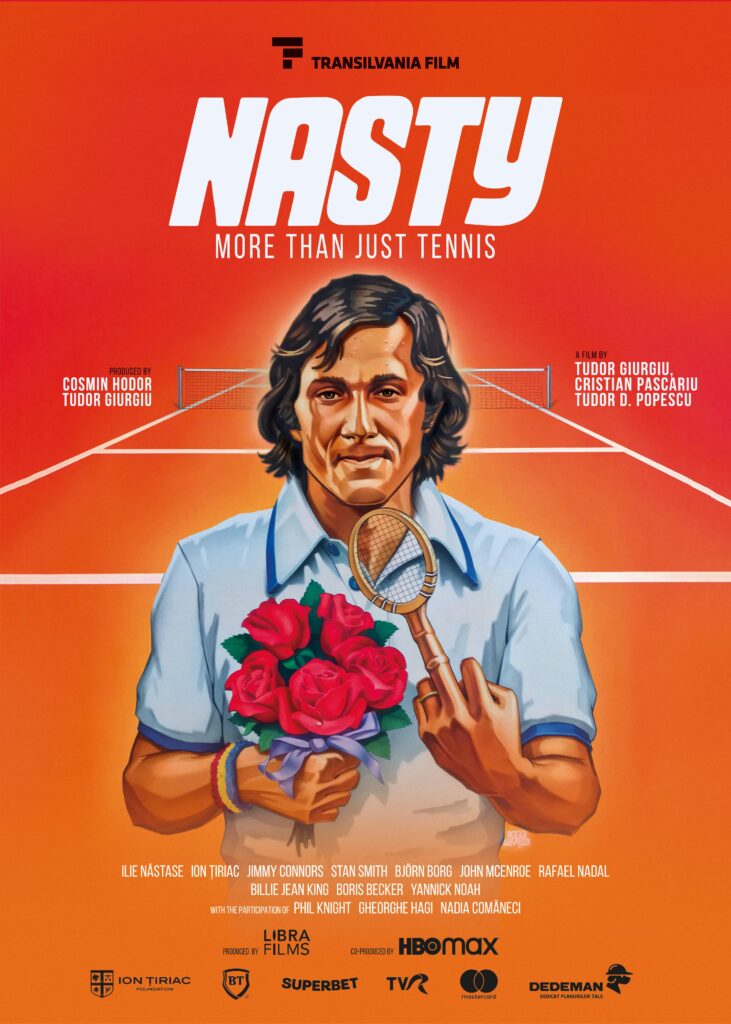Nasty Review

In 1972, Ilie Nastase a tennis player from Romania. He won the US Open, reached the Wimbledon final and was ruling supreme in the Davis Cup, whose final would be played in Bucharest. Oh, and he’d also just signed with a little-known sportswear brand called Nike. Handsome and charismatic, with a racket talent (and temper) almost superhuman, Nastase was becoming a rock star rebel of the game. This immersive documentary tells the story of his rise as the player they called Nasty, using 1972 as its focal point.
After opening in Romania on 19 April to become that country’s box office No1 movie, Cannes Special Screening Nasty plays a day before it starts streaming on HBO Max (which co-produces) across Europe this month. Directed by Romanian filmmaking trio Tudor Giurgiu (also founder of Transylvania Film Festival), Cristian Pascariu and Tudor D Popescu among them working have recently included an intriguing selection of shorts: A Night In Tokoriki, Pinocchio, The Christmas Gift it should attract fans of both tennis generally and lively films about tennis specifically such as McEnroe, Boom! Boom! The World Vs Boris Becker, Borg Vs McEnroe and Battle Of The Sexes. Also helpful in broadening its potential audience may be that last year Luca Guadagnino made Challengers.
Nastase is quite the character. Born in Bucharest in 1946, he took up tennis at a young age and moved into singles matches after forming an unbeatable doubles partnership with former ice hockey player Ion Tiriac when both were still in their early twenties. But it was Stockholm ’69 where things really started happening for him. There he beat Americans Stan Smith et al.
The talent is undeniable whether captured on colour or black-and-white archive footage set to a pulsing score by composer Marius Leftăraș. Nastase on court was poetry in motion, able to return shots from almost impossible angles. It was this, combined with his personality, that made him such a huge figure in the sport. Mischievous and hot-headed he loved to wind up the crowd, yelling and swearing and generally being unsportsmanlike in a way that tennis hadn’t previously seen.
Plenty of footage shows Nastase at full throttle; the public clearly lapped it up, turning out in droves to see him play. Many within the game credit him with opening it up to the masses, helping transform tennis into the professional money-spinner it would become in the mid-’70s. But his opponents didn’t find him quite so amusing. We see Ashe’s walk-off against him during their 1975 match (we also hear about her from other players), McEnroe recalling how Nastase “defaulted himself” during their encounter when Superbrat was still a teenager and an interview with Derek Hardwick (then head of the ITF) reveals how Nasty’s behaviour led directly to today’s tighter code of conduct.
The movie doesn’t delve too deeply into the darker sides of Nasty’s character, which appear to have persisted into old age. But it does include footage of his racist 2017 remarks about Serena Williams’ unborn child, for which Nastase then Romania’s Fed Cup captain received a four-year ban from the sport. (It skips over his verbal abuse of female officials, players and journalists at the same event.) Now 77 and occasionally speaking to the camera himself, Nastase isn’t pressed on these more recent outbursts; he’ll go only so far as to describe himself as “passionate.”
A string of talking heads tennis greats like King, McEnroe, Becker and Rafael Nadal together with sports journalists and a host of women including model Cheryl Tiegs acknowledge Nastase’s rebelliousness but all paint him as a lovable rogue. (None of his five ex-wives is featured.) Ashe also can’t speak to how it felt being called “Negroni” by Nastase; according to his contemporaries, that was well-meaning “locker room banter.” The Romanian was himself nicknamed “Commie.”
Indeed, Nastase’s relationship with his home country provides the film’s most intriguing thread; not least because his rise to prominence coincided with Romania’s efforts to break away from Moscow’s orbit. As former junior US diplomat Jonathan B Rickert puts it: Before Nastase emerged from behind the Iron Curtain, most Americans couldn’t have pointed Romania out on a map. He speaks of the pressure he felt when he brought back Davis Cup in 1972 (“We won one set,” says King); by an odd coincidence that remains unremarked upon in this documentary, Romanians had their first taste of Coca-Cola just a year earlier. And when Nicolae Ceausescu was toppled in 1989 by which time Nastase had long since retired as a player the one-time “second most important person” in Romania was there to help lead the revolution.
Watch Nasty For Free On Gomovies.
.jpg?w=1024&resize=1024,1024&ssl=1)
.jpg?w=1024&resize=1024,1024&ssl=1)
.jpg?w=1024&resize=1024,1024&ssl=1)
.jpg?w=1024&resize=1024,1024&ssl=1)
.webp?w=1024&resize=1024,1024&ssl=1)
.jpg?w=1024&resize=1024,1024&ssl=1)
.jpg?w=1024&resize=1024,1024&ssl=1)
.jpg?w=1024&resize=1024,1024&ssl=1)